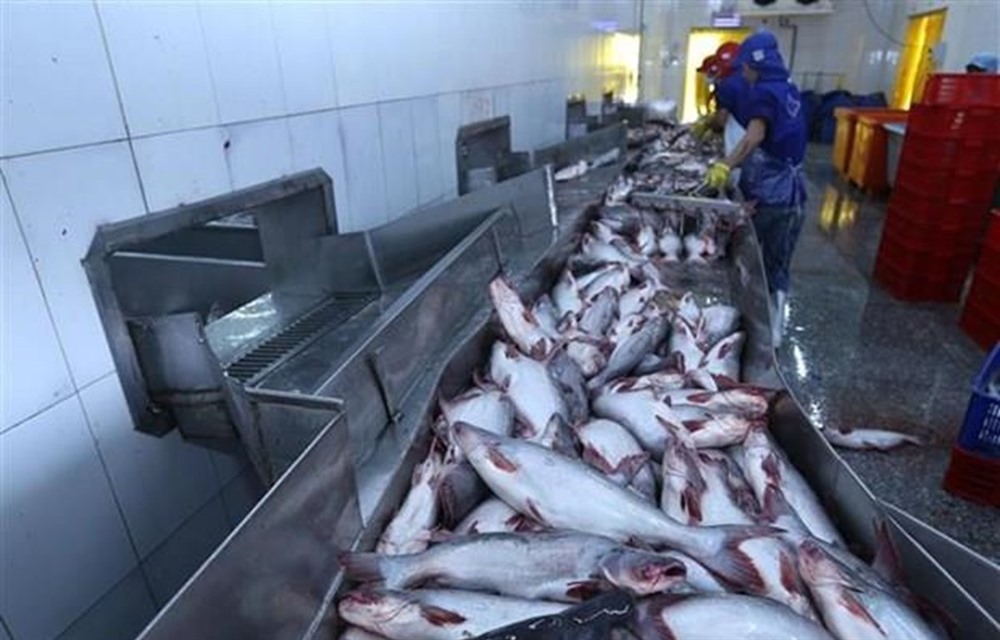 Economy
Economy

The agricultural sector gained a trade surplus of US$1 billion in the first two months of this year despite a year-on-year decrease of 1.6 per cent in export value.
 |
| The export of aquatic products earned the country $1.1 billion in the first two months of the year, up 4.4 per cent year on year. — Photo hanoimoi.com.vn |
HÀ NỘI — The agricultural sector gained a trade surplus of US$1 billion in the first two months of this year despite a year-on-year decrease of 1.6 per cent in export value.
According to the Ministry of Agriculture and Rural Development (MARD), the sector earned $5.5 billion from the export of farm produce and forestry and aquatic products.
Meanwhile, $4.5 billion worth of agro-forestry-fishery products were imported in the reviewed period, up 3 per cent from the same period last year.
In the two months, the reduction in total export revenue was partly due to a fall of 10.1 per cent in export value of farm produce to $2.71 billion while that of animal husbandry hit $77 million, down 7 per cent.
Nguyễn Trung Kiên, head of the Department of Market Research and Commodities under the Institute of Policy and Strategy for Agriculture and Rural Development, said bright spots of the agriculture sector were still seafood and forest products with year-on-year export growth at 4.4 per cent to $1.1 billion and 12.8 per cent to $1.5 billion, respectively, in the first two months of this year.
During the first two months, rice exports were estimated at 837,000 tonnes in volume and $364 million in value. Those figures rose 1.1 per cent in volume but dropped 10.4 per cent in value year on year. Of which, in February, the volume of exported rice was estimated at 399,000 tonnes, earning $169 million.
Nguyễn Quốc Toản, Acting Director of the ministry’s Department of Agro Processing and Market Development, said in the first quarter of this year, the Ministry of Agriculture and Rural Development will send a working group to the Philippines to take part in trade promotion activities to boost rice exports.
Other products’ exports with increases in volume but reductions in value during the first two months included rubber up 22.4 per cent in volume to 228,000 tonnes but down 6.8 per cent in value to $293 million and pepper up 4.3 per cent in volume to 31,000 tonnes but down 20.4 per cent in value to $92 million.
Meanwhile, coffee exports decreased in both volume and value, at 7.5 per cent and 10.8 per cent year on year to 326,000 tonnes and $610 million, respectively.
Seafood exports
The export of aquatic products earned the country $1.1 billion in the first two months, up 4.4 per cent year on year.
According to the MARD’s Department of Farm Product Processing and Market Development, the top four export markets of Việt Nam’s seafood products in the period were Japan, the US, China and South Korea, accounting for 53 per cent of the total export value.
Strong growth was recorded in shipments to Mexico (32.4 per cent), Canada (27.8 per cent), the US (24.9 per cent) and Japan (17.7 per cent).
The department forecast that Vietnamese tra fish exporters will face strong competition from Myanmar in the Chinese market, as Myanmar will soon complete a tra fis farming complex.
However, there is good news for shrimp exporters as they will benefit from favourable tariffs under the Comprehensive and Progressive Agreement for Trans-Pacific Partnership (CPTPP) effective on January 14 this year in Việt Nam.
The department envisioned two-digit growth for shrimp shipments to Japan in 2019 while advising the exporters to renew their approach to the Japanese market, enhance promotion of products and continue to improve product quality.
Fruit, veg exports
The export turnover of fruits and vegetables fell 9.9 per cent year-on-year to $584 million in the first two months, according to the department.
The reduction was attributed to fluctuations of the fruit and vegetable market in February due to the prolonged Lunar New Year (Tết holiday).
China was the largest export market for Vietnamese fruits and vegetables in January with 72.6 per cent of the total exports.
Strong growth was also seen in South Korea (68.2 per cent), the Netherlands (60.2 per cent), Australia (54.8 per cent) and the United Arab Emirates (36.8 per cent).
In February, the US allowed the imports of fresh mangoes from Việt Nam. This is the sixth fruit exported to the market, after dragon fruit, longan, rambutan, lychee and star apple.
Last year, the US was one of the markets with the most impressive growth of 37 per cent compared to 2017. It is forecast that Việt Nam’s fruit exports to the US will continue seeing high growth thanks to the export of mangoes. — VNS




